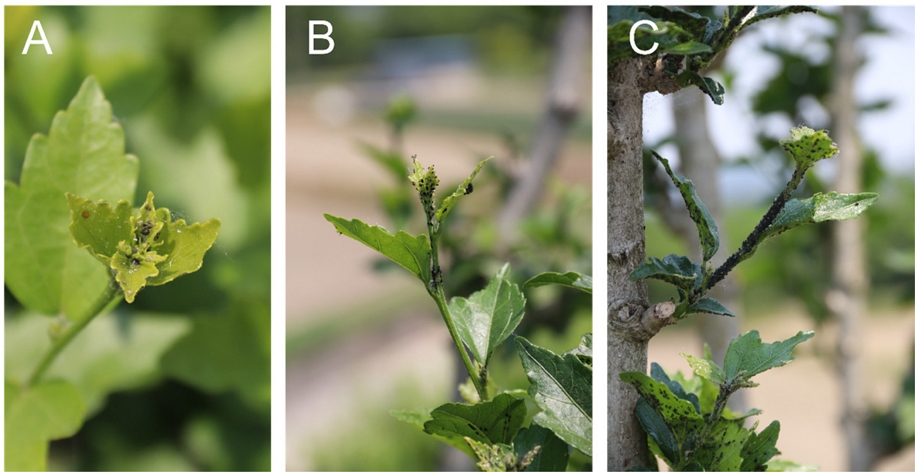
무궁화 발생 목화진딧물의 효율적인 방제를 위한 유기농업자재의 신초부분살포법 설정
초록
2016년 12월 ‘무궁화의 보급 및 관리 조항’이 산림자원법에 신설이후 무궁화에 대한 친밀도와 그것의 활용성을 높이는 다양한 시도가 진행되고 있다. 목화진딧물은 무궁화에 발생하는 대표적인 해충으로 현재까지 해당 해충에 적용가능한 방제제와 야외 약효 평가 방법은 전무한 실정이다. 무궁화는 주로 공원과 거리에서 관상용 및 가로수로 식재되어 있으므로, 약효평가시 화분매개충을 보호하고 비의도적인 약제 노출의 최소화를 고려할 필요가 있다. 적합한 야외 약효 평가 방법 설정을 위해, 우선적으로 계층적 클러스터링 분석을 적용하여 무궁화에 발생하는 야외 목화진딧물 약효 평가에 참고할 수 있는 방법을 스크리닝하였다. 그 결과, 과수작물에 발생하는 진딧물에 적용하는 2가지 약효평가법(method01, method02)이 가장 유사한 방법인 것을 확인하였다. methods01과 method02를 참고하여 약효 평가 시 약제의 비산을 최소화하고 살포구역을 확보할 수 있는 ‘신초부분살포법(ToSS)’을 설정하였고, 2022년 4월 중순에서 6월 초순까지 야외 현장에서 적합성을 평가하였다. 실내 실험에서 약효 우수성이 검증된 유기농업자재 4종과 대조구 약제 2종을 선정하여 약효를 평가하였다. 그 결과 실내 엽침지법에서 우수한 약효를 보였던 Test01, Test03, Test04에서 처리 2일차부터 80% 이상의 사충률이 확인되었다. 신초부분살포법은 약제 살포 범위를 최소화하여 유기농업자재와 화학합성 농약의 무궁화 발생 목화진딧물의 약효 평가에 적용 가능한 것으로 판단된다. 향후, 기존의 주당 살포방법과 신초부분살포법 간의 비교 평가를 통해 적합성을 검증하는 것이 필요하다.
Abstract
Since the ‘Dissemination and management of rose of sharon (Hibiscus syriacus, Mugunghwa)’ was newly legislated in the Forest Resources Act in December 2016, various attempts are being made to increase the familiarity to the peoples and its usability. Cotton aphid (Aphis gossypii) is a representative pest that occurs in H. syriacus, and there are no registered synthetic chemical pesticides and field pesticide efficacy evaluation guidelines so far. Due to the H. syriacus is mainly planted as ornamental and street trees, the pollinators protection and unintentional exposures should be firstly considered during the efficacy evaluation. To establish the efficacy evaluation methods, first of all, we screened out the mostly similar field efficacy evaluation method by using hierarchal clustering analysis among the nine candidate methods. Two types of field evaluation methods for fruit crops (method01 and method02) were revealed close cases of A. gossypii for H. syriacus. By referring the method01 and method02, a topical shoot spray method (ToSS) was newly established to minimize the unintentional problems (such as pesticide scattering occurring several negative effects, securing pesticide application area) and its appropriateness were evaluated by on-site experiment during mid-April to early-June in 2022. Four organic agricultural materials which was high efficacy under the leaf dipping method in the laboratory were chosen and topically sprayed to A. gossypii on the shoot with two synthetic chemical insecticides as control. As a result, a mortality rate of over 80% was confirmed from the second day of treatment in Test01, Test03, and Test04. In summary, it is judged that the ToSS can be applied to the efficacy evaluation in organic agricultural materials and chemically synthesized pesticides by minimizing the spraying range. In the future, it is necessary to verify suitability through comparative evaluation between the existing weekly spraying method and the ToSS method.
Keywords:
Hibiscus syriacus, Aphis gossypii, Field efficacy evaluation, Organic agricultural materials키워드:
무궁화, 목화진딧물, 야외 약효 평가방법, 유기농업자재서 론
산림자원의 조성 및 관리에 관한 법률 제 8절에 ‘무궁화의 보급 및 관리’ 조항이 2016년 12월에 신설됨에 따라 무궁화진흥계획의 연차별 시행계획 수립 및 시행, 무궁화에 관한 실태조사, 그리고 무궁화 식재 및 관리가 시행되고 있다(Legislation, 2023). 무궁화 관리에 대한 법률적 근거가 마련됨에 따라 지자체 별로 다양한 품종의 무궁화가 식재되고 있으며 무궁화 품종 보존에서 보급까지 체계적인 연구 또한 진행되고 있다. 이는 우수한 형질을 지닌 무궁화의 보급은 무궁화 식재률의 증가 및 국민적 관심을 높이는 계기가 되었으나, 관상 및 조경이 목적인 무궁화의 애호심을 높이기 위한 해충 관리 방안은 상대적으로 연구가 부족한 실정이다.
목화진딧물은 무궁화를 비롯한 여러 작물들을 직접적으로 가해할 뿐만 아니라 감로 배설을 통한 그을음병 유발, 식물병원성 바이러스 매개 등 전세계적으로 심각한 경제적 피해를 주는 주요 해충이다(Ebert and Cartwright, 1997). 국내 무궁화는 목화진딧물의 대표적인 1차 월동기주로 알려져 있는데 무궁화에서 월동한 목화진딧물은 이듬해 4월부터 발생, 5-6월부터 급격하게 밀도가 증가한 후 원예, 과수, 화훼 작물 등의 여름기주로 이동하는 것으로 알려져 있다(Paik, 1972; Shim et al., 1979). 이러한 목화진딧물의 생태적 특징은 농경지 인근에 심겨진 무궁화에 대한 농업인의 염려를 불러 일으킬 뿐만 아니라 목화진딧물의 직·간접적인 피해로 인한 미관 하락을 통해 일반인들의 친밀도를 낮추는 주요 원인이 되고 있다. 무궁화에 발생하는 해충 상을 조사하기 위하여 2018년부터 2020년까지 수원과 부산의 무궁화 재배 포장을 조사한 결과, 노린재목 19종, 딱정벌레목 7종, 나비목 7종, 그리고 대벌레목 1종으로 전체 34종이 서식하는 것으로 보고되었다. 이들의 종 동정 결과, 밀도가 가장 높은 해충은 목화진딧물이였으며 그 다음으로 점노랑들명나방, 썩덩나무노린재, 그리고 목화명나방 순으로 조사되었다(Jung et al., 2021).
목화진딧물의 경제적 피해를 줄이기 위한 방제 방법으로는 물리적 방제법, 화학적 방제법, 생물학적 방제법이 알려져 있으며(Sarwar et al., 2014), 이중 화학합성 농약을 활용한 화학적 방제법이 일반적으로 사용되고 있다. 국내 화학 합성 농약 사용은 농약관리법에 따라 등록된 수목, 농작물 및 이들에 발생하는 병해충 적용을 원칙으로 하고 있으나(RDA, 2022), 2022년을 기준으로 무궁화에 발생하는 목화진딧물을 대상으로 등록된 화학합성 농약은 전무한 실정이다.
국내 농작물에 발생하는 병해충에 대한 화학합성 농약의 약효 및 약해 평가 가이드라인은 국립농업과학원의 ‘농약의 등록을 위해 약효 평가 세부 지침 기준’ 을 따르고 있으며(NIAS, 2018), 해당 가이드 라인에는 벼, 과수, 밭작물, 화훼, 수목, 잔디 등에 발생하는 나비목, 노린재목, 딱정벌레목 등 주요 해충에 대한 126건의 등록 세부 지침이 제시되어 있다. 그러나, 무궁화에 발생하는 진딧물류에 대한 야외 약효·약해 평가 세부 지침은 빠져 있기 때문에 관행적으로 타작물 진딧물류에 등록된 화학합성 농약을 사용하고 있는 실정이다.
친환경육성법을 토대로 국내에서는 다양한 유기농업자재가 개발 및 보급되고 있다. 2021년을 기준으로 약 311종의 충해관리용 유기농업자재가 등록되어 있으며 이들의 주요 성분으로는 제충국, 고삼, 멀구슬, 데리스, 계피, 님 등 식물추출물들이 대부분을 차지하고 있다(Kwon et al., 2021). 이들 식물추출물 기반의 유기농업자재는 여러 연구결과를 통하여 목화진딧물(Kim et al., 2010), 복숭아혹진딧물(Ryu et al., 2013), 여뀌못털진딧물(Lee et al., 2022) 등 진딧물류에 효과가 있음이 보고된 바 있다. 무궁화는 조경의 목적을 넘어 보급 및 관리에 관한 법률적 근거가 마련될 만큼 국가적 상징성이 높은 수목이다. 그렇기 때문에 무분별한 합성화학농약의 처리보다는 친환경적 관리를 통한 정서적 친밀성을 높이는 방면을 고려하지 않을 수 없다. 최근 무궁화을 포함한 고추, 오이에서 채집한 목화진딧물의 야외 계통을 대상으로 38종의 농자재를 엽침지법을 통하여 실내 조건에서 스크리닝한 결과, 8종의 충해관리용 유기농업자재가 목화진딧물에 우수한 방제 효과가 있음을 확인하였다(Kim et al., 2023). 하지만 이들 실험 결과의 현장 적용을 위해서는 선발된 우수 약제들의 야외 살포 약효 검정 및 효율적인 처리법에 대한 연구가 필요하다.
본 연구는 유기농업자재의 야외 약효 적합성을 평가하기 위해 클러스터링 분석을 이용하여 기존의 화학합성 농약 약효평가법 중 무궁화에 도입 적용 가능한 약효평가법을 선발하고, 선행 보고되었던 실내 약효평가 실험에서 약효가 우수했던 8종의 유기농업자재 중 4종을 대상으로 야외 적합 여부를 평가하였다. 본 연구 결과를 토대로 무궁화에 발생하는 목화진딧물의 안전하고 효과적인 방제를 위한 유기농업자재 및 등록을 위한 세부적 약효평가 세부지침을 제안하고자 한다.
재료 및 방법
무궁화 발생 목화진딧물 약효평가법 선발
무궁화에 발생하는 목화진딧물에 대한 화학합성 농약 및 유기농업자재의 약효평가 기준은 제정된 바 없기 때문에 ‘농약등록시험 약효·약해분야 세부지침’(살충제편, 이하 ‘세부지침’)(NIAS, 2018)을 기반으로 기주식물인 ‘무궁화’와 유사한 특성을 갖는 과수, 밭작물, 화훼 그리고 수목을 1차적으로 선발하였다. 이후, 이들 기주식물에 발생하는 진딧물류을 포함한 분류학적 유사 그룹인 노린재류까지 대상을 넓혀 2차 재선발한 결과, 총 9종의 후보 약효평가법(Method01~Method09)을 선정하였다(Table 1). 선정된 9종의 후보 약효평가법의 대상작물, 대상해충, 피해령기, 실험실시 시기 및 최소발생밀도, 시험포 선정, 시험규모, 시험배치, 약제처리 횟수, 약효조사방법, 약효조사기준 및 횟수, 약효 조사 항목 등의 세부지침은 Supplementary table 1와 같다.

Several candidates of efficacy evaluation methods which were listed at pesticide registration methods (NIAAS, 2018) for Aphis gossypii in Hibiscus syriacus
선정된 9종의 후보 약효평가법의 세부지침과 무궁화 목화진딧물 간의 계층적 클러스터링 분석을 위하여 기주식물 그룹 유사성, 기주식물 서식환경유사성, 기주식물 재배방식유사성, 기주식물 내 발생하는 해충 유사성, 해충발생부위 유사성, 약제처리 방법 유사성, 약제시험규모 유사성 등 총 7개 항목에 대하여 0-2까지 기준값(index)을 부여하였다(Supplementary table 2, Supplementary table 3). 이러한 클러스터링 방법은 비지도학습에 속하는 것으로 공통 항목을 추출한 후 지표 값을 제시하면 유사도에 따라서 그룹화할 수 있는 장점이 있다. 부여된 기준값은 상향식 계층적 클러스터링 방법인 weighted pair group method with arithmetic mean (WPGMA)을 이용하여 무궁화에 발생하는 목화진딧물에 용이한 약효평가법을 선발하였으며 이를 덴드 로그램으로 시각화 하였다(http://genomes.urv.es/UPGMA/index.php).
실험 포장 설정 및 목화진딧물 밀도 변동 조사
주로 조경 목적으로 재식되는 무궁화의 특성 상, 무궁화 단일로 된 대규모의 실험 포장을 확보하기는 쉽지 않다. 본 연구는 전라북도 완주군 고산면 앞대산 터널 인근 가로수로 재식된 무궁화 167주를 선정하여 진행하였으며, 무궁화 발생 목화진딧물에 대한 유기농업자재의 약효 평가와 무궁화에서의 목화진딧물 밀도 변동을 확인하고자 하였다.
일반적으로 무궁화에 발생하는 목화진딧물은 4월 하순부터 무궁화 신초 혹은 신엽에 발생하는 것으로 알려져 있기 때문에 본 연구에서는 2022년 4월 19일부터 6월 8일까지 육안으로 밀도 조사를 수행하였으며(Fig. 1), 처리구별 발생한 목화진딧물의 초기 밀도는 Supplementary table 4와 같다. 또한, 표식된 조사주와 더불어 신초를 집중적으로 가해하는 목화진딧물의 특성을 고려하여 목화진딧물이 발생한 신초수를 병행하여 조사하였다. 신초수의 경우, 진딧물의 밀도를 기준으로 ‘상’(100마리 이상 혹은 목화진딧물의 신초상 밀집도 길이가 5 cm 이상), ‘중’(11-100마리 혹은 목화진딧물의 신초 상 밀집도 길이가 5 cm 미만), ‘하’(10마리 미만)로 구분하였다(Supplementary fig. 1). 밀도 변동 데이터는 전체 발생 주수와 발생신초수로 시각화하여 제시하였다.
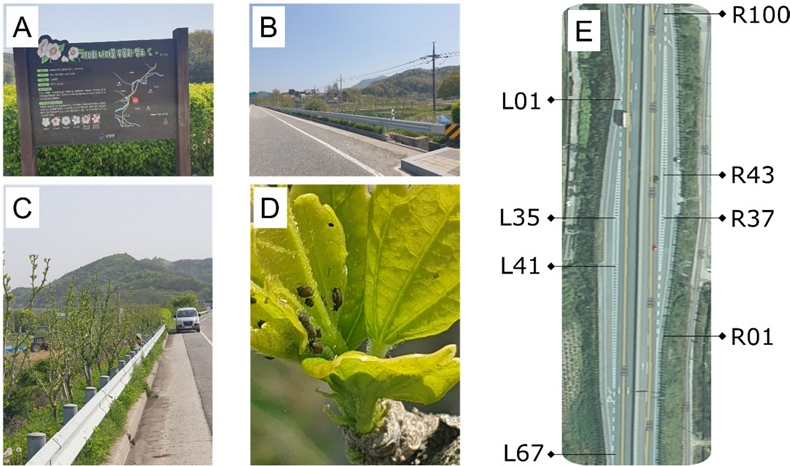
The experiment site for the evaluation of organic agrochemical material efficacy which was located at Gosan-myeon Wanju-gun in Jeollabuk-do. (A) Description about the site as Mugunghwa-myeongso, (B) view of planting on the road side by the direction from Jeonju to Gosan-myeon, (C) view of planting on the road site by the opposite direction, (D) aphid-infected shoot, (E) Location of the labeled-trees by satellite view.
실험 대상 약제 및 신초부분살포법을 이용한 약효 평가
무궁화에 발생한 목화진딧물 사전 밀도 조사 결과를 바탕으로 5월 1일 1회 약제 살포 후, 5월 8일까지 6회의 사충율 조사를 수행하였다. 약제 처리방법은 클러스터링 분석을 통하여 무궁화 발생 목화진딧물과 가장 높은 유사도를 보인 Method01과 Method02 방법을 기준으로 이들 경엽처리법에서 발생할 수 있는 약제 비산을 최소화하기 위하여 변형된 ‘신초부분살포법’으로 약효 평가시험을 수행하였다.
실험 대상 약제로는 대조구 화학합성농약 2종과 유기농업자재 4종을 각각 처리하였으며 무처리구는 실험 약제와 동일한 량의 물을 처리하였다(Table 2). 실험 약제 살포는 표식된 무궁화 신초 부위가 완전히 도포 되도록 수동형 안개 분사 분무기(Airrapa spray atomizer, Netherlands)를 이용하여 10회 살포하였다. 실험 약제당 반복은 3-5회로 수행하였으며 처리 0일차, 1일차, 2일차, 3일차, 4일차, 6일차, 그리고 7일차에 목화진딧물의 생존율을 조사하였다. 생존율을 기반으로한 실험 약제별 약효 결과는 통계분석 프로그램인 R (R Development Core Team, 2020)을 이용하여 일원배치 분산분석을 수행하였다. 조사 차수별 사후 검정은 Tukey’s HSD test를 이용하였으며 통계적 유의성 구분은 R library 내의 multicomp를 이용하였다.
결과 및 고찰
무궁화 목화진딧물과 유사한 약효 평가 세부 지침 선발
농촌진흥청 국립농업과학원에서는 농약의 적용 대상 작물과 병해충을 엄격히 구분하여 등록하도록 상세한 약효 평가 세부 지침을 제시하고 있다(NIAS, 2018). 하지만 무궁화 발생 목화진딧물에 대한 약효 평가 세부 지침은 제시된 바 없기 때문에, 본 연구에서는 국립농업과학원의 ‘살충제 약효 평가 세부지침’에서 선발된 9종의 후보 약효평가법과 유사성 분석을 통하여 무궁화 발생 목화진딧물에 효과적인 약효평가법을 도출하였다.
선발된 9종의 약효평가법에 대한 클러스터링 분석 결과, 무궁화 목화진딧물은 과수에 발생하는 비엽권형 및 엽권형 진딧물 약효평가법(Method01, Method02)이 가장 적합한 것으로 나타났으며(Fig. 2), 덴드로그램의 신뢰성을 나타내는 Cophenetic Correlation Coefficient은 0.938로 높게 나타났다. 클러스터링 분석은 객관적 지표를 통하여 약제 등록 기준이 정해져 있지 않은 수목 해충에 대한 약효평가법을 선발할 수 있기 때문에, 보다 과학적으로 실험 약제 평가를 도출하는데 도움을 줄 수 있을 것이라 판단된다.
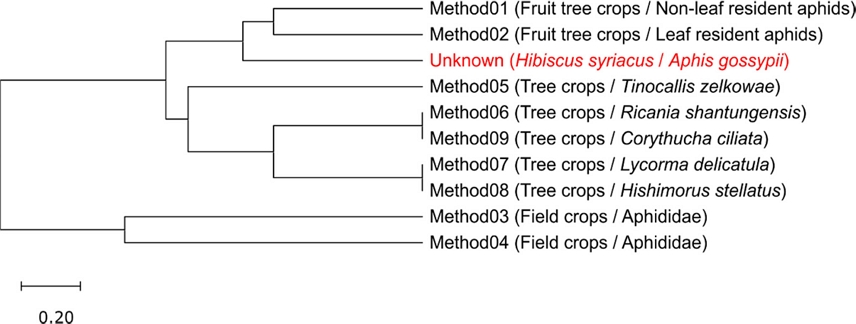
The dendrogram which was constructed by WUPGMA method among several insecticidal efficacy evaluation methods putatively related with Aphis gossypii on Hibiscus syriacus.
과수 진딧물에 발생하는 진딧물은 과수의 신초에 주로 분포하며, 약효평가 방법으로는 주당 혹은 면적을 기준으로 살포하도록 하고 있다. 현재 무궁화에 발생하는 목화진딧물을 대상으로 한 약효 평가 기법은 설정되지 않은 상태이므로 약효평가 가이드라인 설정 시 참고할 만하다. 다만, 과수작물과 달리 무궁화는 주로 가로수로 광범위하게 식재되어 있어, 약효평가 시험구 확보, 비특이적 노출의 최소화등을 고려하여 무궁화에 적합한 약효 평가 가이드라인 설정이 필요하다.
시험 대상 무궁화 식재 구역의 목화진딧물 밀도 변동
4월 19일부터 6월 8일까지 무궁화 포장내 목화진딧물의 밀도 변동을 조사하였다. 4월 19일 처음으로 무궁화 1주에서 목화진딧물이 관찰된 이후 1주, 4주, 31주, 39주, 53주, 108주, 123주로 증가하다 5월 20일을 경계로 4주, 19주, 14주로 급격히 감소하는 것을 확인하였다(Fig. 3). 목화진딧물이 발생한 신초 수 역시 비슷한 양상으로 1개, 4개, 38개, 53개, 160개, 1,159개, 3,654개로 증가 후 20개, 71개, 84개로 급격한 감소 양상을 보였으며(Fig. 3), 10-100마리 사이의 신초가 가장 높은 빈도를 차지하는 것으로 나타났다. 이러한 밀도 변동의 원인으로는 5월 20일 지자체에서 수행한 약제 살포가 영향을 미쳤을 것이라 추정된다(data not shown). Kim 등(Kim et al., 2013) 이 보고한 대전광역시 내 무궁화 발생 목화진딧물의 밀도 변동 조사 결과를 살펴보면 4월 넷째주에 한 주당 1마리 수준으로 발생, 5월 첫째 주 주당 약 69마리 발생, 6월 셋째주부터 8월 첫째주까지 무발생, 8월둘째주부터 9월 첫째주까지 주당 1.35마리가 발생하여 이후 소멸하는 것으로 확인되었다. 본 연구에서는 5월 말경에 약제 살포로 인해 지속적인 모니터링 수행은 어려웠지만 발생 최성기는 5월 중순경으로 판단된다.
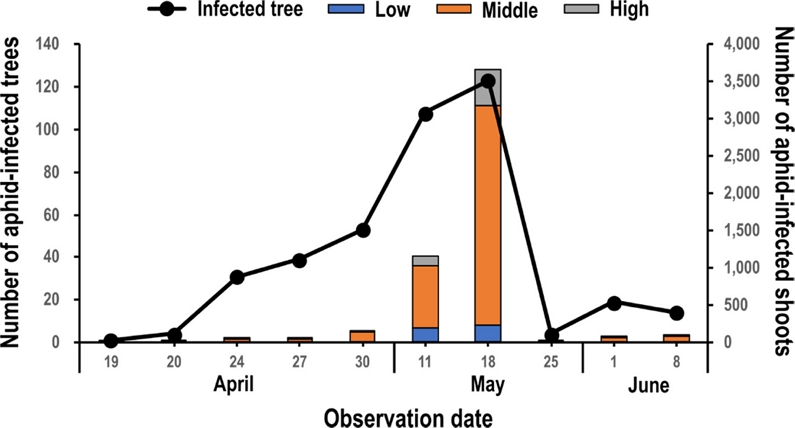
Number of aphid-infected tree and shoots between Apr. 19 and Jun. 8 in Mugunghwa myeongso which was located at Wanju-gun, Jeolla-bukdo. The number of shoots were divided by ‘Low (< 10 aphids)’, ‘Middle (Approximately 10 ~ 99 aphid individuals with less than 5 cm length of aphid colonies on shoots)’ and ‘High (Over 100 aphid individuals with over 5 cm length of aphid colonies on shoots)’.
신초부분살포법을 통한 약효 평가
무궁화는 과수재배와 달리 재배지역 및 면적이 구역화 되어 있지 않고 도심의 가로수 및 공원의 정원수로 재식되는 경우가 일반적이다. 그렇기 때문에 약제 처리 시 주위 환경에 대한 영향을 반드시 고려해야 할 필요성이 있다. 본 연구는 약제 비산을 최소화하기 위하여 신초부분살포법을 적용하여 무궁화 발생 목화진딧물에 대한 약제 약효를 평가하였다. 약제의 약효를 정확히 판단하기 위해서는 무처리구 밀도의 변동이 중요한데, 본 연구의 조사 결과, 처리 3일차 무처리구 일부 반복구의 목화진딧물 밀도가 30마리에서 0마리로 급격히 변동하여 통계적 유의성 분석은 수행하지 못하였다(Supplementary table 5). 이의 원인으로는 무처리구 목화진딧물 마릿수의 급격한 변동 기간에 거미와 무당벌레 등의 천적 밀도 증가가 영향을 준 것으로 판단된다. 제한된 데이터에도 불구하고 본 연구에서는 무처리구의 결과가 약효 평가 결과에 영향을 미치지 않는 것이므로 판단하여 대조구 약제와 처리구 약제 실험을 지속하였다.
Con_01, Con_2 대조구는 화학합성 농약인 카보설판 액상수화제와 설폭사플로르 액상수화제를 선정하였다. 이들 농약은 목화진딧물 방제에 등록된 화학합성 살충제로써 작용 기작 01과 04에 해당한다. 이들 대조구의 반복수는 4반복으로 약제 처리 초기 밀도는 각각 214마리와 410마리로 조사되었는데, 약제처리 1일차부터 목화진딧물의 생존율은 각각 13.5%와 2.8%로나타나 통계적으로도 유의한 급감을 보였다(Con_01, F6, 21 = 75.28, P < 0.001; Con_02, F6, 21 = 3,501, P < 0.001) (Fig. 4).
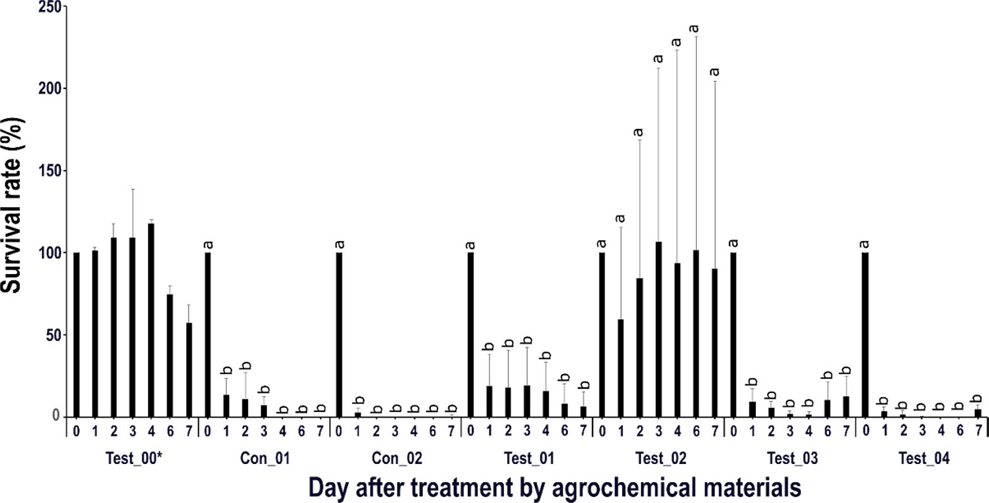
Survival rate for 7 days after treatment of agrochemical materials against Aphis gossypii. Small alphabetical characters on graph represents the statistical significance which was determined by Tukey’s HSD tests.
유기농업자재인 Test_01의 처리 전 발생밀도는 540마리였으며 살포 후 7일 동안 생존율은 19%, 17.8%, 19.3%, 15.7%, 8.4%, 6.3%로 나타나 속효성은 보이지 않았으나 생존율 변동성은 통계적으로 유의함을 확인하였다(F6, 21=11.7, P < 0.001)(Fig. 4). 유기농업자재 Test_03은 처리 전 290마리를 대상으로 살포를 수행하였으며 살포 후 7일 동안 생존율은 9.2%, 5.7%, 1.8%, 1.3%, 10.2%, 12.5%로 나타나 속효성 및 통계적인 유의성 변동을 확인하였다(F6, 21= 72.63, P < 0.001)(Fig. 4). 해당 약제는 살포 후 6일차부터 밀도가 10% 이상 증가하였지만 전반적으로 80% 이상의 방제효과를 나타내었다. 유기농업자재 Test_04은 처리 전 340마리를 대상으로 살포를 수행하였으며 살포 후 7일 동안 생존율은 3.5%, 1.5%, 0.3%, 0%, 0%, 4.5%로 속효성 및 안정적인 약효가 확인되었으며 약제 처리전 대비 생존율 변동성도 통계적으로 유의하였다(F6, 21 = 1,428, P < 0.001)(Fig. 4). 그러나 유기농업자재인 처리구 약제 Test_02는 야외 현장에서 약효를 확인할 수 없었다. 결론적으로 실험에 사용된 유기농업자재 Test_01, Test_03, Test_04는 화학합성농약인 대조구 약제와 비교하였을 때, 무궁화 목화진딧물에 대한 살충효과가 있음을 확인하였으며 이중 Test_04는 처리 1일차 사충률이 가장 높고 이후 지속적으로 높은 방제효과를 나타내어 야외현장에서 무궁화 목화진딧물을 억제하는데 가장 우수한 유기농업자재로 판단된다. 이상의 결과를 토대로 유기농업자재의 신초부분살포법을 통하여 야외 무궁화에 발생하는 목화진딧물의 방제가 가능함을 확인하였다.
본 연구에 사용된 유기농업자재 4종은 실내 엽침지 실험에서 80% 이상의 높은 사충률을 보인 우수한 약제로(Kim et al., 2023), 본 야외 실험에서도 Test_02를 제외하고 일관성 있는 높은 사충률을 나타내었다. 이러한 결과는 실내 사전 스크리닝이 최적 약제 선발 및 현장 해충 방제 가능성을 예측하는 효율적인 툴이 될 수 있다는 것을 제시한다. 또한, 약제 비산을 최소화하며 높은 방제효과를 나타낸 신초부분 살포법은 무궁화 목화진딧물을 방제하기 위한 적합한 약효 평가가 될 수 있다.
무궁화에 발생하는 목화진딧물의 약효 평가 가이드라인 제안
무궁화 발생 목화진딧물은 신초를 주로 가해하는 해충으로 과수에서의 비엽권형 진딧물류인 조팝나무진딧물, 복숭아혹진딧물, 복숭아가루진딧물류와 가해 양상이 유사하여 이에 상응한 약효 평가 가이드라인의 적용이 가능하다(Method01). 비엽권형 진딧물의 약효 조사 방법은 구당 5개 이상의 신초에 표식을 한 후, 살포 전 사전 진딧물류의 밀도 조사 및 살포 후 3일차와 7일차에 약효를 평가하도록 하고 있는데 해당 평가법은 무궁화 발생 목화진딧물의 야외 약제 약효 평가 가이드라인으로 직접적으로 활용할 수 있을 것이다. 다만, 현실적인 상황을 고려할 때 무궁화는 농경지와 달리 대규모로 재식된 포장지가 거의 없고 조경 목적의 특성상 인간 및 비표적 생물에 대한 약제 노출이 발생할 수 있기 때문에 약효 평가 시 약제 비산의 최소화를 반드시 평가 세부 지침에 고려해야 할 것이다. 또한, 무궁화는 조경 용도 외에도 국가적 상징성을 갖고 있는 수목이기 때문에 발생 가능한 해충의 친환경적 관리를 위한 유기농업자재 목록화 및 세부 지침이 마련되어야 한다.
세부 지침의 설정을 위해서 다음과 같이 실험지 선정 및 약효 평가법에 대한 세부사항을 고려해야할 것이다. 우선, 전년도 무궁화의 목화진딧물 발생 지역을 우선적으로 선정하고 가급적 인적이 잦은 공원이 아닌 가로수로 식재된 곳을 선정한다. 만약, 공원을 평가지로 선정했을 경우 약제 사용에 대한 사전 정보 확보하여야 한다. 실험 포장이 선정되면 지역내 무궁화 재배 관리자에게 농약 살포 계획을 사전 문의한 후, 실험에 대한 협조를 구하여야 하며 약제 처리에 앞서 비산에 의해 영향이 우려되는 환경인지를 확인하여야 한다. 약제 살포 범위는 무궁화 식재 환경을 고려하여 신초 부분 또는 주당 처리 살포를 통해 약제의 비산 및 주변 영향을 최소화하며 처리구당 반복수는 최소 3반복 이상, 신초 당 진딧물의 밀도가 평균 50 마리 이상 발생 시 처리하는게 적합할 것이다(25마리의 경우 무당벌레 등 천적의 간섭으로 개체수에 영향을 줄 수 있음). 약제 살포는 가급적 무궁화 개화 전이나 진딧물의 밀도가 최상에 도달하기 1-2주전 또는 천적(거미나 무당벌레)의 밀도가 본격적으로 증가 전 기간을 선정하는 것이 바람직하다. 무궁화 발생 목화진딧물의 약효평가는 기존의 약효 평가 기준과 같이 약제처리전, 약제처리 후 1, 3, 7일차를 조사하고, 분석 결과를 토대로 80-100%의 높은 사충률을 보이는 자재를 선발한다.
본 연구에 사용된 신초부분살포법은 소규모로 다양한 후보 약제들을 빠르게 평가할 수 있는 장점을 지니고 있다고 판단된다. 또한 부분살포를 통하여 비표적 생물에 대한 영향을 최소화하며 높은 방제효과를 기대할 수 있다. 그러나, 기존의 주당 살포방법을 대체할 수 있는 약효평가법으로 인정받기 위해서는 두 약효평가법 간의 정밀한 비교 연구가 필요할 것으로 사료된다. 국내에서는 해충을 기준으로 벼, 과수, 밭작물, 화훼, 수목, 그리고 잔디에 적용할 수 있는 약효 평가방법이 구축되어 있다. 대상 해충이 다양해지고 신규약제가 개발되는 이 시점에 시간과 비용을 절감함과 동시에 약효를 평가할 수 있는 기법들에 대한 정리와 연구가 필요하다.
Acknowledgments
본 연구는 2021년 국립산림과학원의 ‘나라꽃 무궁화 보급활성화 및 산업소재화 연구(FG0403-2018-01-2021)’의 연구비와 농림축산식품부의 재원으로 농림식품기술기획평가원의 ‘핵심농자재 국산화기술개발사업(321054-05)’의 지원을 받아 수행되었음.
이해상충관계
저자는 이해상충관계가 없음을 선언합니다.
References
- Ebert T, Cartwright B, 1997. Biology and ecology of Aphis gossypii Glover (Homoptera: aphididae). Southwest. Entomol 22(1):116-153.
- Jung J-K, Kim M, Lee CY, Jang B-J, Kim D, et al., 2021. Comparison of insect pest communities on 30 cultivars of Hibiscus syriacus. J. Korean Soc. For. Sci. 110(1):116-127
- Kim D-I, Kim S-G, Kim S-G, Ko S-J, Kang B-R, et al., 2010. Characteristics and toxicity of Chrysanthemum sp. line by extract part and methods against Tetranychus urticae, Nilaparvata lugens, and Aphis gossypii. Korean J. Org. Agric. 18(4):573-586.
-
Kim MH, Im JS, Ahn YK, Kwon H-Y, Park Y, et al., 2023. Insecticidal efficacy monitoring of agricultural materials against Aphis gossypii populations collected at agricultural and forestry area. Korean. J. Pestic. Sci. 27(2):75-84.
[https://doi.org/10.7585/kjps.2023.27.2.75]

-
Kim Y, Cho Y, Kang Y-K, Choi M, Nam S-H, 2013. A study of the major insect pest communities associated with Hibiscus syriacus (Columniferae, Malvaceae). J. Ecol. Environ. 36(2):125-129.
[https://doi.org/10.5141/ecoenv.2013.016]

-
Kwon DH, Kwack G-Y, Won SM, Kim MH, Choi HJ, et al., 2021. Establishment of classification system of major ingredients in organic agricultural materials associated with insect pest control. Korean. J. Pestic. Sci. 25(4):287-304.
[https://doi.org/10.7585/kjps.2021.25.4.287]

- Lee SK, Jung CR, Han K-S, Park B, 2022. Control efficacy of organic materials against artichoke aphid (Capitophorus elaeagni, Del Guercio) that damage Korean thistle. Korean J. Appl. Entomol. 61(2):293-297.
- Legislation MoG, 2023. Creation and Management of Forest Resources Act.
- NIAS. (2018). Detailed instruction of pesticide registration test for efficacy and negative effect: Insecticide: RDA.
- Paik WH, 1972. Aphididae. Illustrated Encyclopedia of fauna and flora of Korea. Vol. 13. Insecta 5. Ministry of Education, Seoul (in Korean).
- R Development Core Team. (2020). R: A language and environment for statistical computing. Vienna, Austria. : R Foundation for Statistical Computing. Retrieved from https://www.R-project.org/
- RDA. (2022). Pesticide Safety Information System (PSIS). Retrieved 14 Aug. 2022 https://psis.rda.go.kr/
-
Ryu T-H, Park S-E, Ko N-Y, Kim J-G, Shin H-S, et al., 2013. Seasonal occurrences of insect pests and control effects of eco-friendly agricultural materials (EFAMs) in the field of Lycium chinense under environment-friendly management. Korean. J. Pestic. Sci. 17(4):402-410.
[https://doi.org/10.7585/kjps.2013.17.4.402]

- Sarwar MK, Azam I, Iram N, Iqbal W, Rashda A, et al., 2014. Cotton aphid Aphis Gossypii L. (Homoptera; Aphididae); A challenging Pest; biology an control strategies: A Review.
- Shim JY, Park JS, Paik WH, 1979. Studies on the life history of cotton aphid, Aphis gossypii Glover (Homoptera). Korean. J. Pl. Prot. 18(2):85-88.
Appendix

Summary of similar methods for the control of Aphis gossypii on H. syriacus which was described in efficacy test of insecticides

Survival rate against two insecticides (Con_01 and Con_02) and four organic agricultural materials (Test_01 ~ Test_04) in Aphis gossypii on the Hibiscus syriacus by partial shoot spray method. Statistical significances were shown with parenthesized small alphabetical letter which determined by Tukey’s HSD test
Deok Ho Kwon, Data analysis, Writing, Draft review, https://orcid.org/0000-0003-2162-4771
Young Hee Lee, Data collection, Density observation
Jae Seong Im, Draft review
Yul Gyun Ahn, Draft review, Information collection, Writing
Hye Youn Kwon, Draft review, Experiment
Hanna Shin, Draft review, Data collection

